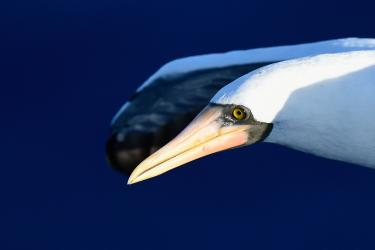The Gulf of Mexico is a critical marine region that provides breeding, staging, migration, and wintering habitat for a wide variety of North America’s birds. Yet information remains sparse about seabird species composition, distribution, and abundance Gulf-wide.
As part of NOAA’s Southeast 2023 Vessel Surveys for Abundance and Distribution of Marine Mammals and Seabirds project, scientists will gather information about seabirds for restoration planning and evaluation. They will also provide additional data to inform decision-makers related to proposed offshore energy development and aquaculture on the Outer Continental Shelf. The study will further improve restoration planning to ensure that projects are designed to provide maximum benefits to seabird species injured during the Deepwater Horizon oil spill.
A Busy Hub for Migration
A recent study found that around 76 percent of pelagic seabirds that use Gulf of Mexico habitat breed on lands outside the Gulf of Mexico region. But, the Gulf is an area that birds migrate through to reach critical breeding and wintering habitats. Birds passing through can be exposed to threats or adverse impacts in the Gulf.
“Some birds have very long migration patterns into the Gulf of Mexico,” Jon Andrew, a bird scientist, explains. “For example, the band-rumped storm-petrel, which we have photographed on both survey legs this summer, breeds during winter on the eastern North Atlantic islands, such as the Azores, Madeira, Selvagens, Canaries, and Berlengas (near Portugal).”
It is critical to gain knowledge on species abundance, habitat use, and flight patterns for informed management. Data and updated models from the 2023 vessel survey program will inform long-term conservation and management of seabird populations in the area.
First Leg
The seabird observers had great weather and considerable success! They were able to document the post-breeding migrations of species such as Audubon’s shearwater and bridled tern. The observers detected 18 species of pelagic, offshore, and coastal open water seabirds. They archived 2,139 total sightings of seabirds into Program SeeBird software. Their detection rate averaged 231 birds per day, or around 18 birds per hour.
Several rare species for the Gulf of Mexico were noted on leg 1, including red-footed booby, red-billed tropicbird, and black-capped petrels. Only one sub-adult masked booby was detected on this leg. But as many as five adult, sub-adult, and/or juvenile brown boobies could be seen foraging simultaneously for flying fish off the ship’s bow. During previous Gulf surveys, the brown booby was one of the most widely detected species of seabird. Scientists hope to explore hypotheses about when and why this species’ range has extended so widely.
Second Leg
Lisa Hug, a bird scientist noted, “The long duration of leg 2 has given us a lot more time to add different species to the growing data archive for Gulf seabirds, especially since we have ventured into some of the less-explored western parts of the Gulf of Mexico.”
At the end of the second leg the bird scientists sighted more than 2,057 individual seabirds belonging to 18 different species.
Observers detected two more red-footed boobies, a species about which very little is known in the Gulf. There were a few differences in the marine birds that were found in the second leg compared to the first. Observers detected more than 50 Cory’s shearwaters, another bird that migrates to the Gulf from far away. It comes from the Mediterranean Sea. For reasons unknown, sightings of Cory’s shearwater are more prevalent in the western Gulf.
The team also found small flocks of black terns that were rather far offshore. This species holds considerable interest because its breeding habitat in the northern prairies is declining from changing land use and droughts. The team also sighted post-breeding yellow warblers that were headed towards the east coast of Mexico and Central America. Similar to leg 1 of this survey, the brown booby was one the most widespread seabirds sighted.
The Future of Seabird Science in the Gulf
Scientists are eager to begin analyzing what has become one of the largest standardized data sets for seabirds ever collected for a single region. This survey is expected to be repeated again in 2024 to build on the dataset. From 2010 until now, there have been 550 days and 57,000 kilometers of trackline surveyed for seabirds in the Gulf, but further research is needed. More research will assist resource managers that are tasked with protecting, managing, and conserving seabird species and will keep building a solid foundation for future decision-making.
Terra Mar Applied Sciences, is contracted by the U.S. Fish and Wildlife Service Gulf Restoration Office and have partnered with this vessel survey with a focus on seabirds.
Meet the Blogger
Ellie Hartman
Ellie Hartman was born and raised in Breckenridge, Colorado. She was a communications intern, research assistant, and marine mammal observer for NOAA's Southeast Science Center. She graduated from Barry University with a Master's of Business Administration and graduated from University of Miami with a Master's of Professional Science in Marine Conservation. Meet Ellie







